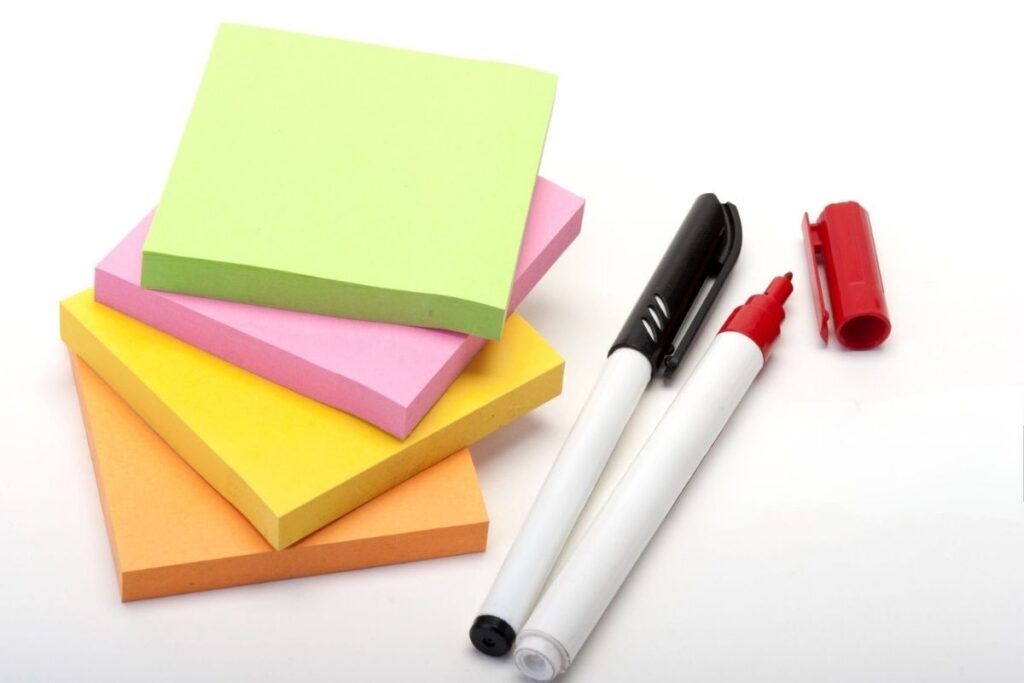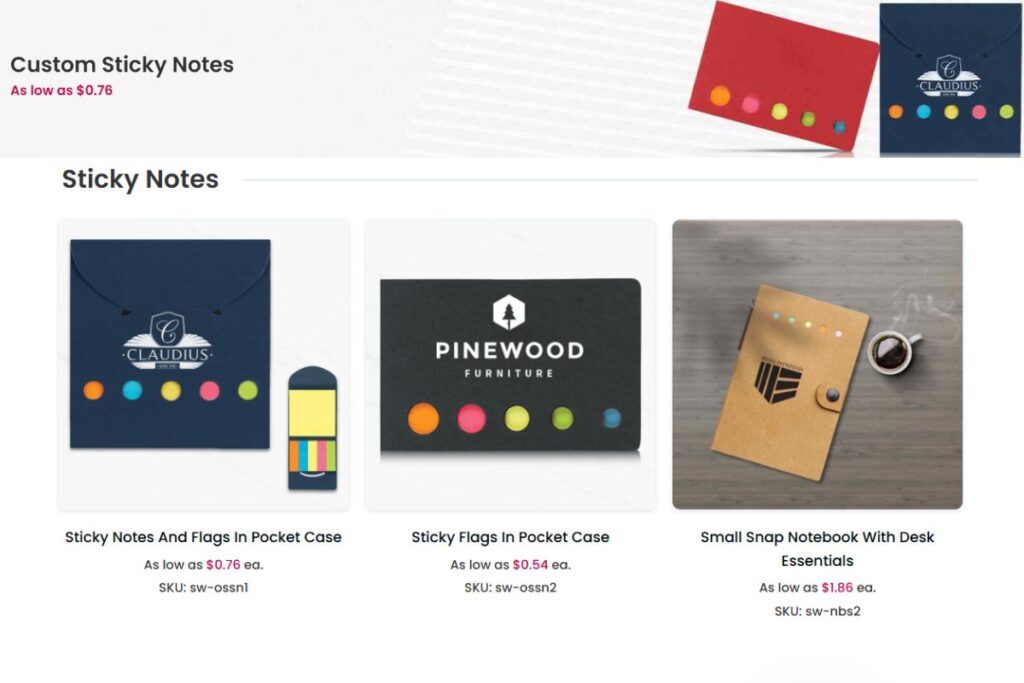Introduction
Sticky notes are a staple of productivity in homes, offices, and classrooms. But behind every brightly colored square lies a bigger environmental story. Most traditional sticky notes are made from virgin paper, meaning trees are harvested, energy is used in excess, and waste is produced—just to create a temporary note.
So, what’s the alternative?
Eco-friendly recycled sticky notes.
Made from post-consumer waste and sustainable fibers, these sticky notes offer the same functionality as their traditional counterparts—without the environmental guilt. Whether you’re a business owner trying to green your brand, a teacher introducing sustainability to students, or an eco-conscious shopper, this guide will show you how a small change can lead to a big impact.
What Makes Sticky Notes Eco-Friendly?
Understanding what makes sticky notes environmentally friendly is the first step toward making a better choice. Not all sticky notes labeled as “green” are created equal, so here are the core features you should look for:
1. Made from Recycled or Renewable Materials
Eco-friendly sticky notes are often made from:
- Post-Consumer Waste (PCW): Paper that has already served its purpose and been recycled, reducing demand for new pulp.
- Alternative Fibers: Materials like bamboo, sugarcane bagasse, or cotton scraps can replace traditional wood pulp.
These materials give new life to waste, supporting the circular economy and preventing unnecessary tree cutting.
2. Sustainable Manufacturing Process
A product is only as eco-friendly as the way it’s made. Look for sticky notes that:
- Are produced with low water usage
- Use renewable energy sources where possible
- Contain vegetable- or soy-based inks for non-toxic printing
- Feature water-based adhesives without harsh chemicals or pollutants
3. Trusted Certifications
To ensure authenticity, check for these eco-certifications:
- FSC Recycled – Ensures the paper is responsibly sourced
- Green Seal – Confirms the product meets environmental standards
- BPI Certified – Proves compostability in commercial settings
Environmental Benefits of Recycled Sticky Notes

Switching to recycled sticky notes isn’t just a trend—it’s a meaningful step toward reducing your ecological footprint. While they seem small, the collective impact of millions of sticky notes used worldwide every day is massive. When you choose recycled options, you’re contributing to a more sustainable, circular economy.
1. Reduces Deforestation
Traditional sticky notes are made from virgin paper, which requires cutting down trees—often from old-growth forests. By using post-consumer recycled paper, recycled sticky notes prevent unnecessary logging, conserving biodiversity and reducing habitat loss.
2. Lowers Carbon Emissions
Producing paper from recycled materials uses up to 74% less energy and 50% less water than making it from raw wood pulp. This means fewer greenhouse gas emissions, less fossil fuel consumption, and a reduced carbon footprint overall.
3. Minimizes Landfill Waste
Each recycled sticky note prevents paper waste from ending up in landfills. Since many eco-sticky notes are biodegradable and even compostable, they break down naturally without leaving harmful residues. This reduces landfill overflow and methane gas production from decomposing waste.
4. Reduces Chemical Pollution
Eco-friendly sticky notes typically use water-based adhesives and soy-based inks, which are free from harsh solvents and toxins found in conventional printing. This lowers the risk of soil and water contamination during manufacturing and disposal.
5. Promotes Circular Economy
By purchasing sticky notes made from post-consumer recycled material, you actively support the demand for recycling infrastructure. This encourages companies to repurpose waste rather than extract new raw materials, creating a more circular, waste-free supply chain.
Top Eco-Friendly Sticky Note Brands in 2025

Looking for high-quality recycled sticky notes? Here are some of the top brands leading the way in sustainability:
1. Swagify (Best for Custom Orders)
Swagify offers fully customizable recycled sticky notes—perfect for companies looking to distribute eco-branded merchandise at events, in employee kits, or as client gifts.
Why choose Swagify?
- Quick turnaround for branded orders
- Recycled paper options with soy-based ink
- Ideal for bulk corporate gifting
2. GreenLine Paper Co.
An industry pioneer, this company offers 100% recycled sticky notes with FSC certification and compostable options, making them a top choice for eco-focused offices and schools.
3. EcoEnclose
This Colorado-based brand uses kraft paper and avoids plastic entirely. Their sticky notes are perfect for eCommerce businesses looking to add sustainable touches to packaging or operations.
4. Decomposition Books
Famous for their artistic notebooks, they also offer sticky notes made from 100% post-consumer waste—ideal for teachers, artists, and students.
5. Stickies
Known for using plant-based adhesives and vegan-friendly materials, this brand appeals to personal users looking for ethical office supplies.
Creative Uses for Recycled Sticky Notes
| Use Case | Description |
|---|---|
| Daily To-Do Lists | Jot down daily tasks or priorities and stick them on your desk or screen. |
| Bookmarks with Notes | Use as bookmarks that double as space for reminders or page summaries. |
| Color-Coded Study Aids | Assign different colors to subjects or topics for quick visual learning. |
| Quick Reminders on Mirrors | Leave motivational quotes or reminders on mirrors, doors, or fridges. |
| Message Board for Family/Team | Use them to leave notes or updates for roommates, family, or coworkers. |
| Brainstorming & Idea Mapping | Stick notes on a wall to visually organize thoughts, ideas, or workflows. |
| Labeling & Sorting | Temporary labels for documents, containers, or shelves during organization. |
| Creative Art Projects | Use them to make collages, pop-up cards, or wall mosaics. |
| Mini Gratitude Wall | Write one thing you’re grateful for daily and post it on a wall or board. |
| Recyclable Gift Tags | Fold and write messages on them to use as eco-friendly gift tags. |
Sustainable sticky notes aren’t just for reminders. Their uses are versatile, practical, and creative:
For Businesses & Offices
- Add them to green onboarding kits to show new hires your commitment to sustainability.
- Use them at workstations with company branding and eco messages.
- Include in client appreciation boxes with personalized, eco-conscious flair.
For Schools & Universities
- Introduce them as part of a school-wide green initiative.
- Use for interactive lessons about recycling and conservation.
- Incorporate into eco-club projects, campaigns, and fundraisers.
For Eco-Conscious Individuals
- Replace disposable note pads in your home office.
- Add them to your zero-waste planner for daily tasks and meal plans.
- Use for DIY bookmarks, vision boards, or labeling items without plastic.
Where to Buy Recycled Sticky Notes
Ready to shop sustainably? Here’s where to start:
- Swagify: Ideal for custom business orders with quick delivery and eco-friendly inks.
- EarthHero: An online eco marketplace with several brands of recycled office supplies.
- Package Free Shop: Great for personal orders and gift bundles.
- Etsy: Handmade and customizable eco-friendly sticky notes by small makers.
- Local Zero-Waste Stores: Support community businesses while reducing carbon from shipping.
Cost Comparison: Recycled vs. Traditional Sticky Notes

Many people hesitate to make the switch due to perceived cost. But let’s break it down:
- Recycled sticky notes may cost slightly more upfront—about 10–20% higher than traditional ones.
- However, when ordered in bulk or through a business account, the price per pad can drop significantly.
- Factor in the eco-value and positive brand impact, and the ROI becomes clear.
Pro Tip: Reduce waste and cost by buying larger pads or multi-packs instead of single sticky notes.
How to Make the Switch to Sustainable Sticky Notes
| Step | Description |
|---|---|
| 1. Assess Current Usage | Evaluate how often and where you use sticky notes in your daily routine. |
| 2. Choose Recycled Materials | Opt for sticky notes made from post-consumer recycled paper or eco-certified sources. |
| 3. Look for Non-Toxic Adhesive | Select products with plant-based or solvent-free glue to reduce environmental impact. |
| 4. Buy in Bulk | Reduces packaging waste and shipping emissions while saving costs. |
| 5. Support Eco-Friendly Brands | Purchase from companies committed to sustainable sourcing and production. |
| 6. Use Mindfully | Avoid overuse—stick only when needed, reuse when possible, and write on both sides. |
| 7. Recycle After Use | Dispose of used notes properly; some are compostable or recyclable depending on local guidelines. |
| 8. Spread Awareness | Encourage coworkers, classmates, or family to adopt eco alternatives. |
| 9. Personalize for Motivation | Use custom eco sticky notes with inspiring quotes or your brand to make sustainability appealing. |
| 10. Track Your Impact | Monitor usage reduction or waste savings to stay motivated and promote change. |
Making your office, home, or business more sustainable doesn’t have to be overwhelming. Transitioning to recycled sticky notes is one of the simplest and most cost-effective ways to begin your eco-friendly journey.
Here’s how to do it strategically:
1. Audit Your Sticky Note Usage
Start by identifying how many sticky notes you and your team use monthly or annually. Most offices use thousands of sticky notes each year—replacing even a portion with eco-friendly versions makes a big impact.
Tip: Track which departments or individuals use them the most. This helps prioritize bulk purchases and saves money long-term.
2. Start with a Trial Pack
Before making a full switch, order a small batch of recycled sticky notes from a trusted supplier like Swagify or EcoEnclose. Test them for:
- Stickiness and reusability
- Ink compatibility (pens, markers, pencils)
- Print quality (for branded designs)
3. Communicate the Why
Educate your team or family members on why switching matters. Share facts about paper waste, deforestation, or carbon footprints to inspire buy-in.
Example internal message:
“By switching to recycled sticky notes, we’ll save over 5,000 sheets of virgin paper annually—enough to protect one full-grown tree.”
4. Buy in Bulk
Recycled sticky notes are slightly more expensive per unit—but when you buy in bulk, you get significant discounts. This is especially helpful for schools, nonprofits, or businesses with consistent demand.
Pro Tip: Look for bundle deals that include other eco-friendly supplies like recycled notebooks or plantable pens.
5. Incorporate Custom Branding
If you run a business, custom-branded recycled sticky notes are a double win. You reinforce your brand identity while showcasing your commitment to sustainability.
Swagify and other custom printing services allow you to:
- Add your logo using soy-based ink
- Choose kraft paper or pastel tones
- Opt for eco packaging (no plastic wrapping)
6. Pair With Other Green Swaps
Sticky notes are just the beginning. Maximize your sustainability commitment by pairing them with:
- Bamboo or recycled pens
- Digital workflow apps (to reduce unnecessary printing)
- FSC-certified printer paper
This holistic approach strengthens your environmental credibility and builds trust with eco-conscious customers.
Conclusion: Stick Sustainably
Recycled sticky notes are one of the easiest ways to reduce waste without compromising convenience or productivity. With the same level of performance, they offer a tangible step toward a greener office, school, or home.
Whether you’re managing a company or organizing your week, every sticky note is a chance to make a positive impact.



